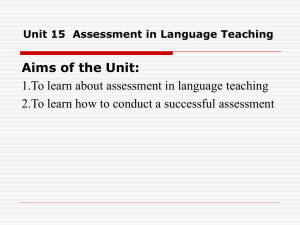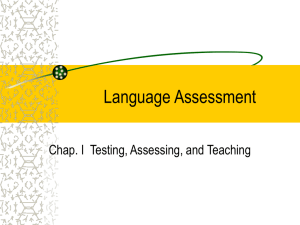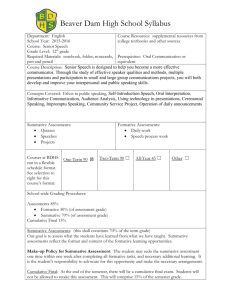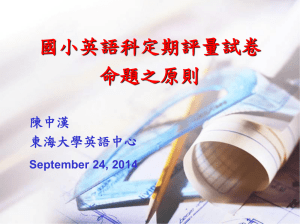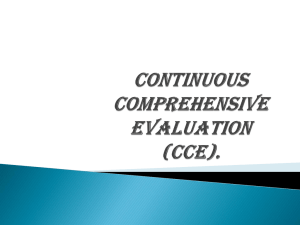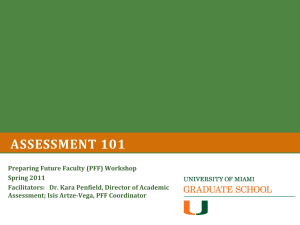Artefact 3 - Rachael Evans ePortfolio
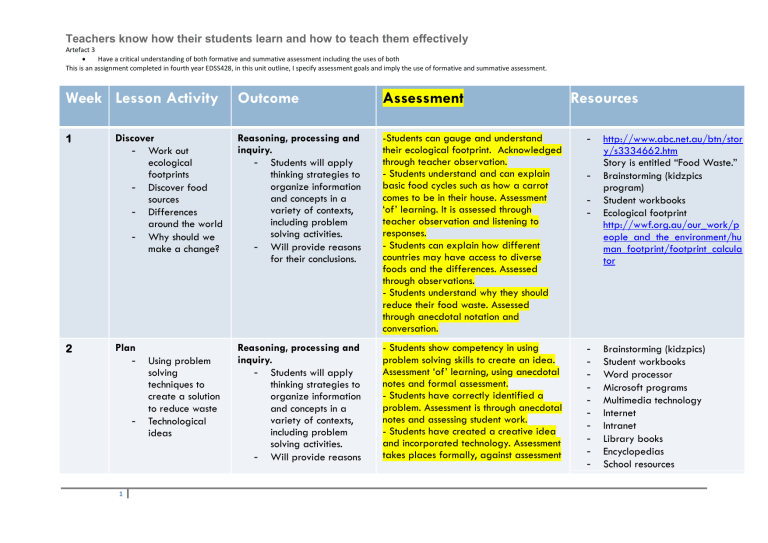
Teachers know how their students learn and how to teach them effectively
Artefact 3
Have a critical understanding of both formative and summative assessment including the uses of both
This is an assignment completed in fourth year EDSS428, in this unit outline, I specify assessment goals and imply the use of formative and summative assessment.
Week Lesson Activity Outcome Assessment
1
Resources
2
Discover
- Work out ecological footprints
- Discover food sources
- Differences around the world
- Why should we make a change?
Reasoning, processing and inquiry.
- Students will apply thinking strategies to organize information and concepts in a variety of contexts, including problem solving activities.
- Will provide reasons for their conclusions.
Plan
- Using problem solving techniques to create a solution to reduce waste
- Technological ideas
Reasoning, processing and inquiry.
- Students will apply thinking strategies to organize information and concepts in a variety of contexts, including problem solving activities.
- Will provide reasons
-Students can gauge and understand their ecological footprint. Acknowledged through teacher observation.
- Students understand and can explain basic food cycles such as how a carrot comes to be in their house. Assessment
‘of’ learning. It is assessed through teacher observation and listening to responses.
- Students can explain how different countries may have access to diverse foods and the differences. Assessed through observations.
- Students understand why they should reduce their food waste. Assessed through anecdotal notation and conversation.
- Students show competency in using problem solving skills to create an idea.
Assessment ‘of’ learning, using anecdotal notes and formal assessment.
- Students have correctly identified a problem. Assessment is through anecdotal notes and assessing student work.
- Students have created a creative idea and incorporated technology. Assessment takes places formally, against assessment
- http://www.abc.net.au/btn/stor y/s3334662.htm
Story is entitled “Food Waste.”
- Brainstorming (kidzpics program)
- Student workbooks
- Ecological footprint http://wwf.org.au/our_work/p eople_and_the_environment/hu man_footprint/footprint_calcula tor
- Brainstorming (kidzpics)
- Student workbooks
- Word processor
- Microsoft programs
- Multimedia technology
- Internet
- Intranet
- Library books
- Encyclopedias
- School resources
1
Teachers know how their students learn and how to teach them effectively
Artefact 3
Have a critical understanding of both formative and summative assessment including the uses of both
This is an assignment completed in fourth year EDSS428, in this unit outline, I specify assessment goals and imply the use of formative and summative assessment.
Week Lesson Activity Outcome Assessment Resources
3
4
Act
- Students are given time to implement their ideas, create their projects for their conclusions.
Creativity.
- Students apply creative ideas in practical ways and test the possibilities of the ideas they generate.
Creativity.
- Students apply creative ideas in practical ways and test the possibilities of the ideas they generate.
Observe
- Collect data to judge successfulness of project
- Take notes on successes and
Reasoning, processing and inquiry.
- Students will apply thinking strategies to organize information and concepts in a variety of contexts, criteria.
- Newspapers inc local, national, school.
- All media outlets
- Students use the time successfully to create their projects. Assessment is through observations.
- Students attempt to complete the task in a practical, yet creative sense.
Assessment ‘for’ learning is occurring and is through observations.
- School resources (building materials ect.)
- Student workbooks
- Computers
- ICT
- Cameras
- Digital technology
- Internet
- Intranet
- Media outlets
- Microsoft programs
-Students understand and can portray the data they are collecting through explanations. Assessment takes place through observation and listening to students, it is assessment ‘as’ learning and by the teacher collecting the data, it is also assessment ‘of’ learning.
- Microsoft programming
- Student workbooks
- Data collection tool (excel)
2
Teachers know how their students learn and how to teach them effectively
Artefact 3
Have a critical understanding of both formative and summative assessment including the uses of both
This is an assignment completed in fourth year EDSS428, in this unit outline, I specify assessment goals and imply the use of formative and summative assessment.
Week Lesson Activity Outcome Assessment Resources failings of the project
- Alter project in accordance with the notes
- Can use constructive criticism to help another student. including problem solving activities.
- Will provide reasons for their conclusions.
- Students can alter the project in accordance with the observations made to better the outcome. Assessment ‘as’ learning is occurring.
Creativity.
- Students apply creative ideas in practical ways and test the possibilities of the ideas they generate.
- Students can use correct assessment criteria when working with another group to test and assess their progress. This is collected as formal assessment and is assessment ‘of’ learning.
Reflection, evaluation and metacognition
- identify strategies they use to organise their ideas, and use appropriate language to explain their thinking.
- identify and justify changes in their thinking.
3
Teachers know how their students learn and how to teach them effectively
Artefact 3
Have a critical understanding of both formative and summative assessment including the uses of both
This is an assignment completed in fourth year EDSS428, in this unit outline, I specify assessment goals and imply the use of formative and summative assessment.
Week Lesson Activity Outcome Assessment Resources
4 Evaluate
- Write a report on what worked / what didn’t work
- Express what you will continue / discontinue to do, give reasons for why.
Reasoning, processing and inquiry.
- Students will apply thinking strategies to organize information and concepts in a variety of contexts, including problem solving activities.
- Will provide reasons for their conclusions.
Creativity.
- Students apply creative ideas in practical ways and test the possibilities of the ideas they generate.
Reflection, evaluation and metacognition
- Identify strategies they
- Students report accurately and constructively on their project. This is recognised as assessment ‘as’ learning and self assessment are occurring.
- Students can constructively express why they will continue / discontinue their food consumption or waste management task. Assessment ‘as’ learning and self assessment are occurring.
- Student workbooks
- Evaluation forms
- Word processor (extension for student to write a good copy of report)
- Technology used
- Evidence of product / project created
4
Teachers know how their students learn and how to teach them effectively
Artefact 3
Have a critical understanding of both formative and summative assessment including the uses of both
This is an assignment completed in fourth year EDSS428, in this unit outline, I specify assessment goals and imply the use of formative and summative assessment.
Week Lesson Activity Outcome Assessment Resources use to organise their ideas, and use appropriate language to explain their thinking.
- Identify and provide reasons for their point of view, and justify changes in their thinking.
5



